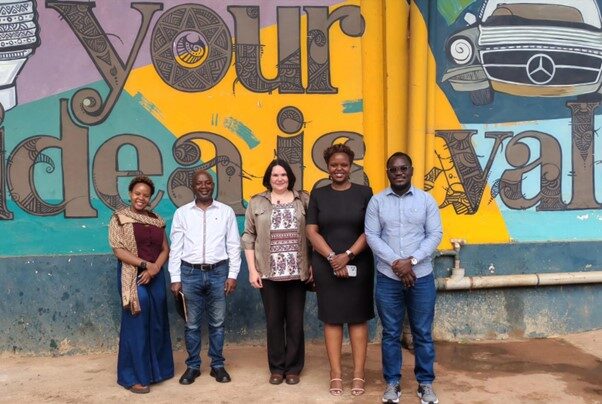The African Research Universities Alliance (ARUA) is a network of leading research-intensive universities across the African continent that aims to build collaborative capacity in addressing Africa’s developmental challenges through high-quality research and innovation. ARUA’s Fifth Biennial International Conference, held from 29–31 October 2025 at Makerere University, Uganda, brought together scholars, policymakers, and practitioners under the theme “Research, Innovation and Artificial Intelligence for Africa’s Transformation.” The event marked ARUA’s tenth anniversary and served as a platform for discussing how Artificial Intelligence (AI) can catalyse sustainable growth, inclusivity, and innovation across key sectors in Africa.
The ARUA/The Guild Cluster of Research Excellence (CoRE) in Creative Economies (Co-led by Rhodes University, King’s College London, and the University of Lagos), organised a special session at the conference to explore the implications of AI for Africa’s Creative Industries and Higher Education, emphasizing collaboration between HEIs and industry. AI is transforming how arts and culture are created and consumed globally. While Creative Industries have been early adopters—particularly in recommendation and personalization algorithms—generative AI (GenAI) introduces new opportunities and challenges. By fostering discussions on AI’s role in Africa’s Creative Industries, this session aimed to bridge gaps between academia and industry, ensuring that HEIs contribute meaningfully to industry resilience and sustainable growth in the digital creative economy.

UniPod Recording Studio, Makerere University
The session was chaired by Dr Anthony Tibaingana of Makerere University, College of Business and Management Sciences. Makerere University is a highly entrepreneurial university and hosts UniPod, a multidisciplinary innovation hub designed to empower youth and innovators by providing access to makerspaces, design labs, and startup support. It includes a fully equipped music and podcast recording studio and editorial suite, providing an excellent example of how African HEIs can link to creative industries production.
Professor Jen Snowball (Rhodes University, South Africa) presented a paper entitled “Creative Economies in Africa, AI and Higher Education,” discussing how universities can support the development of young people in the digital creative economy, using an innovative Visual Special Effects training programme from South Africa as a case study.

MoTIV Research Visit: (Left to right: Amanda Gowa, Community and Programme Development Lead; Anthony Tibaingana, Makerere University; Jen Snowball, Rhodes University; Rita Ngenzi Founding Director, Africa Creatives Alliance and MoTIV), Ivan Sewajje, Head of Brand Innovation, MoTIV)
Professor Mohammed Aminu Sanda (University of Ghana) contributed with a paper titled “Enhancing AI-Oriented Creative Curriculum Towards Sustainable Creative Labour Creation in a Ghanaian Creative Economy.” Prof Sanda discussed ways in which HEI curricula can be better aligned to prepare creative entrepreneurs for the opportunities and challenges that AI offers to the sector.
The session concluded with an industry panel discussion from representatives of the recently launched the Africa Creatives Alliance (ACA). The ACA is a pan-African network and coalition dedicated to empowering Africa’s cultural and creative industries through strategic collaboration, ecosystem building, and investment facilitation. It aims to connect the fragmented creative industries through intermediaries, including creative hubs, incubators, and makerspaces, to build a dynamic continent-wide creative economy characterised by innovation, sustainability and global competitiveness. Panel discussants were Rita Ngenzi (Founding Director, Africa Creatives Alliance), Ivan Sewajje (Head of Brand Innovation), and Amanda Gowa (Community and Programme Development Lead).
This dynamic team also works with MoTIV, a founding partner and the largest innovation hub and maker space in East Africa, located in Kampala, Uganda. MoTIV supports the growth of local designers, makers, and creative businesses by offering access to advanced manufacturing equipment, training, production facilities and market linkages. Through dedicated programs such as their “Design to Industry” initiative, MoTIV empowers youth to shift from creative concept to scalable enterprise by building capacity, generating jobs, and enabling access to factory-level production and broader marketplaces.

Ugandan designer, Lincoln Axarya, at MoTIV’s creative hub in Kampala, showcasing AXARYA – Conscious Creation, a brand that blends contemporary fashion with sustainability and local craftsmanship. MoTIV provides a collaborative space for designers like him to innovate and grow Africa’s creative economy.
The Africa Creatives Alliance recognises the work of intermediaries like MoTIV as critical cornerstones and scalable enablers of Africa’s creative economy by bridging innovation, entrepreneurship, and cultural expression. Their work fosters collaboration between artists, makers, and investors, creating sustainable pathways for creative talent to thrive and positioning Africa’s creative industries as key drivers of inclusive economic growth and social transformation.

Presenters and audience at the The ARUA/The Guild Cluster of Research Excellence in Creative Economies special session at ARUA’s Fifth Biennial International Conference, held from 29–31 October 2025 at Makerere University, Uganda
The ARUA conference session on “AI and Creative Economies”highlighted how such initiatives connect higher education institutions and industry partners in the era of artificial intelligence, showcasing how research can inform practical innovation, support digital upskilling, and stimulate new forms of creative production. By linking academic research with real-world applications, the session demonstrated how collaboration between universities and creative enterprises is essential for building Africa’s capacity to lead in AI-driven creative and cultural innovation.
Report and Photos courtesy of Prof. Jen Snowball
